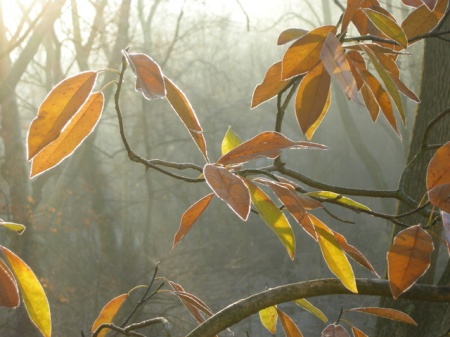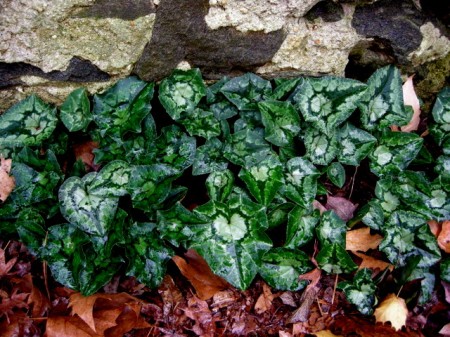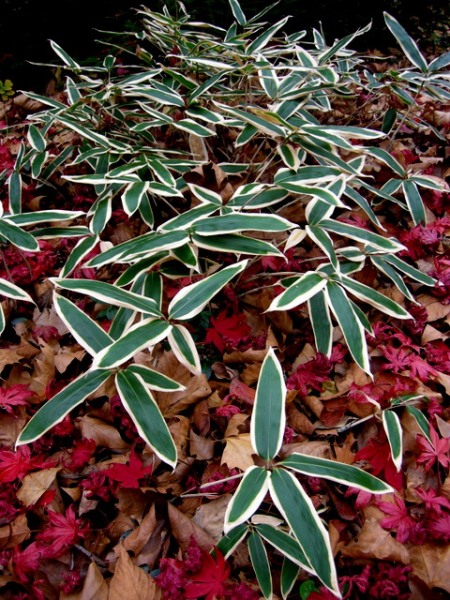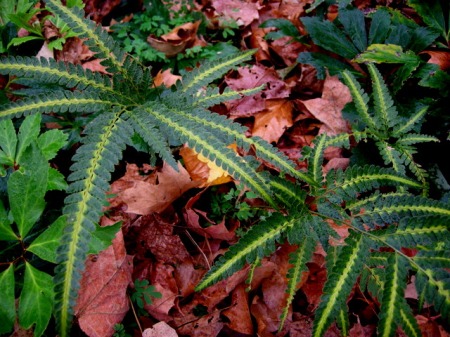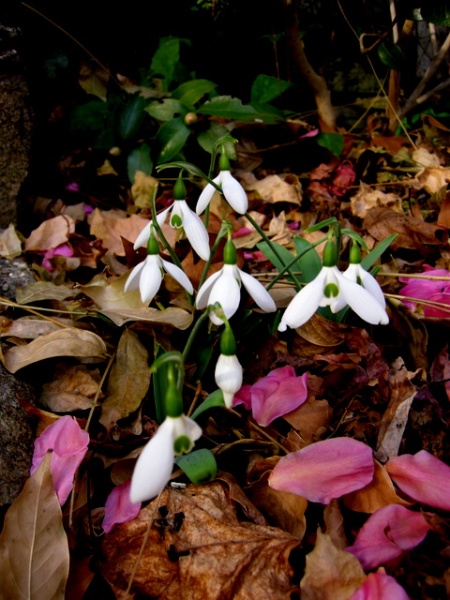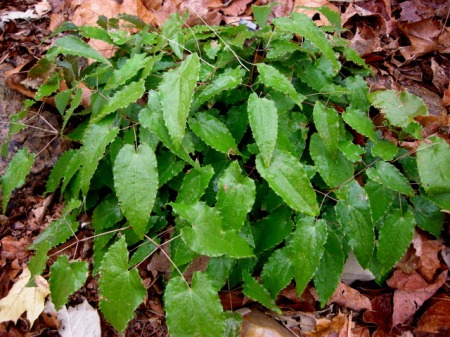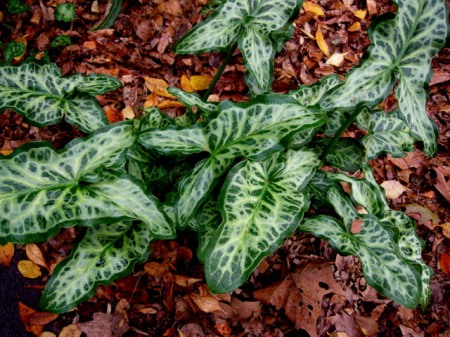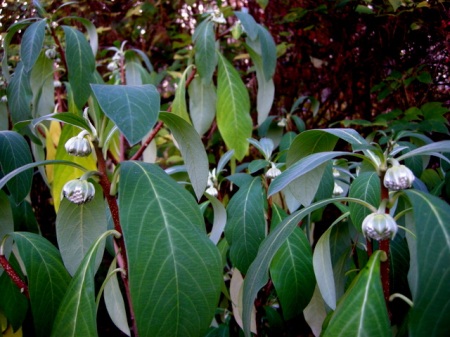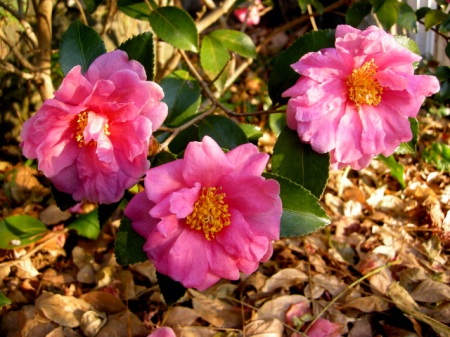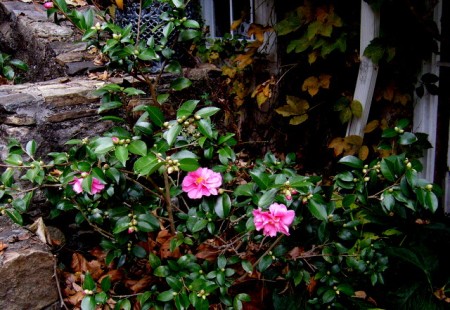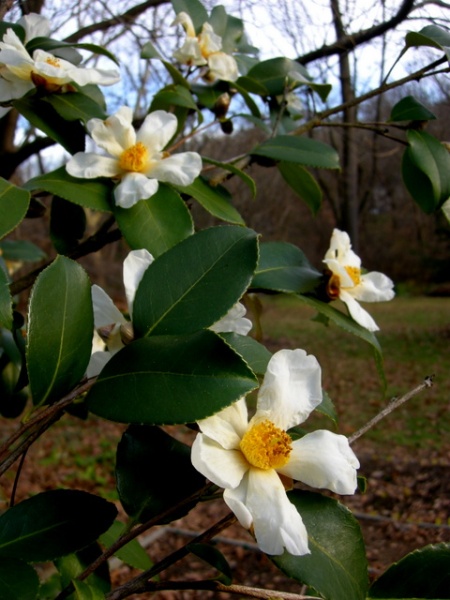 Even though praecox means developing early, ‘Praecox’ Christmas rose hellebore is one of the main season varieties that bloom later in January or February. Here it is in mid-December.
Even though praecox means developing early, ‘Praecox’ Christmas rose hellebore is one of the main season varieties that bloom later in January or February. Here it is in mid-December.
Like much of the country, southeastern Pennsylvania, US, zone 6 to 7, has had unseasonably warm weather for weeks. There has been no snow, the ground has not frozen, we have only had 2 or 3 real frosts, not enough to set back the acanthus, and it was 70 degrees F on Christmas Day. It has also been raining for most of two weeks. Quite a change from the last two falls when it got cold in October and stayed that way. In 2013 to 2014, we experienced record snowfalls. In 2014 to 2015, there was not much snow but record low temperatures.
Nursery News: Carolyn’s Shade Gardens is a retail nursery located in Bryn Mawr, PA, specializing in showy, colorful, and unusual plants for shade. The only plants that we ship are snowdrops and miniature hostas. For catalogues and announcements of events, please send your full name, location, and phone number (for back up use only) to carolyn@carolynsshadegardens.com. Click here to get to the home page of our website for catalogues and information about our nursery and to subscribe to our blog.
.
 ‘Winter’s Joy’ fall-blooming camellia is not blooming early but instead continuing to bloom beyond when its flowers and buds would usually be frozen and done. It started in October and is about to enter its fourth month.
‘Winter’s Joy’ fall-blooming camellia is not blooming early but instead continuing to bloom beyond when its flowers and buds would usually be frozen and done. It started in October and is about to enter its fourth month.
.
Should we be worried? As Mark Rylance, playing a Soviet espionage agent accused of treason, says in “Bridge of Spies”, would it help? Lots of attention needs to be paid to the very serious issue of climate change and what the US in particular can or should do in the face of the incontrovertible evidence of evolutionary temperature changes occurring at faster than evolutionary speeds. But worrying about the plants in our gardens and neighborhoods won’t accomplish much. We can’t control the weather so just relax and enjoy the early flowers. My friend John Lonsdale who is originally from England tells me that if we lived there, this would all be completely normal—the weather and the bloom times. Here is what is early in my garden:
.
 Winter jasmine usually sends out a few flowers through out the winter whenever it gets warm. The whole shrub is in bloom now with not many buds left for later.
Winter jasmine usually sends out a few flowers through out the winter whenever it gets warm. The whole shrub is in bloom now with not many buds left for later.
.
 The giant snowdrop ‘Xmas’ does open flowers by Christmas, but right now the whole patch is in bloom and starting to go by. Last year I had flowers through March.
The giant snowdrop ‘Xmas’ does open flowers by Christmas, but right now the whole patch is in bloom and starting to go by. Last year I had flowers through March.
.
 The giant snowdrop ‘Standing Tall’ also opens its buds around Christmas. It was so early this year that its flowers are now completely done.
The giant snowdrop ‘Standing Tall’ also opens its buds around Christmas. It was so early this year that its flowers are now completely done.
.
 February-blooming ‘Redstart’ pulmonaria or lungwort is in full flower all through my gardens.
February-blooming ‘Redstart’ pulmonaria or lungwort is in full flower all through my gardens.
.
 The lovely, evergreen Japanese mahonia is a late winter bloomer but all my shrubs are in flower.
The lovely, evergreen Japanese mahonia is a late winter bloomer but all my shrubs are in flower.
.
 ‘Winter’s Song’, whose name has been inexplicably changed to ‘Joker’, is a Christmas rose cross that normally waits until late January or February.
‘Winter’s Song’, whose name has been inexplicably changed to ‘Joker’, is a Christmas rose cross that normally waits until late January or February.
.
 Double hybrid hellebores are generally a little later in my garden but this one looks gorgeous today.
Double hybrid hellebores are generally a little later in my garden but this one looks gorgeous today.
.
 How about this for a surprise? On Christmas Day, ‘Rijnveld’s Early Sensation’ opened two flowers. It is the earliest daffodil that I know of but that’s usually February.
How about this for a surprise? On Christmas Day, ‘Rijnveld’s Early Sensation’ opened two flowers. It is the earliest daffodil that I know of but that’s usually February.
.
 Highly fragrant winter-flowering honeysuckle (Lonicera fragrantissima) is blooming. It usually flowers slightly before forsythia.
Highly fragrant winter-flowering honeysuckle (Lonicera fragrantissima) is blooming. It usually flowers slightly before forsythia.
.
 ‘Blue Lady’ hybrid hellebore decided to put on an early show.
‘Blue Lady’ hybrid hellebore decided to put on an early show.
.
 Geum ‘Cooky’ has been flowering all fall.
Geum ‘Cooky’ has been flowering all fall.
.
 One of my favorite snowdrops ‘Fly Fishing’ has been whipping around in all the rain and wind on its extra long, fishing line pedicel (flower stem).
One of my favorite snowdrops ‘Fly Fishing’ has been whipping around in all the rain and wind on its extra long, fishing line pedicel (flower stem).
.
 No open flowers yet, but the edgeworthia flower buds are swelling to form elegant silver tassels.
No open flowers yet, but the edgeworthia flower buds are swelling to form elegant silver tassels.
.
Many people have asked me what will happen in the spring? Most of the plants that are flowering now are using buds that they formed after they were done flowering last spring. If every bud opens, they will not form new buds and will not bloom again. My advice is to enjoy them now!
Carolyn
Nursery Happenings: You can sign up to receive catalogues and emails about nursery events by sending your full name and phone number to carolynsshadegardens@verizon.net. Subscribing to my blog does not sign you up to receive this information.
Carolyn’s Shade Gardens is a local retail nursery in Bryn Mawr, Pennsylvania, U.S., zone 6b/7a. The only plants that we mail order are snowdrops and miniature hostas and only within the US.
Facebook: Carolyn’s Shade Gardens has a Facebook Page where I post single photos, garden tips, and other information that doesn’t fit into a blog post. You can look at my Facebook page here or click the Like button on my right sidebar here.
Notes: Every word that appears in orange on my blog is a link that you can click for more information. If you want to return to my blog’s homepage to access the sidebar information (catalogues, previous articles, etc.) or to subscribe to my blog, just click here.

